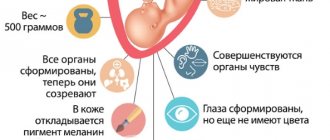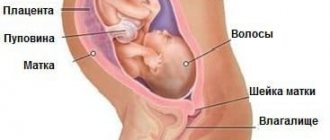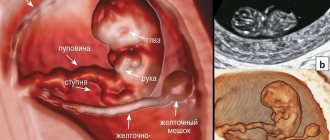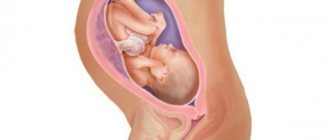The duration of pregnancy is 40 weeks. From the first weeks of conception, the expectant mother worries about how the baby is feeling and whether his heart is beating. You can feel the first physical contact with the fetus no earlier than 18 weeks of gestation. The first kicks made by the baby are invisible to the pregnant woman. They are too tender and impossible to feel. Some women claim that they “hear” the baby from 12-13 weeks, but most likely these sensations are associated with increased intestinal peristalsis.
The first movements are marked by the middle of the gestational period (if this is the first pregnancy).
The potential mother feels the presence of the child and talks to him. The fetus, in turn, responds to touch and voice from the outside.
As the height and weight of the fetus increases, there is less space in the uterine cavity. Muscle tone appears, the pregnant woman feels the motor activity of the baby.
The shocks from the womb are a guarantee that the baby is alive.
By the nature of the kicking, you can determine the baby’s well-being and promptly identify possible developmental pathologies.
At what age does a child begin to move?
The first movements occur during embryogenesis. This is on average 5-6 weeks from the moment of conception. By the end of the first trimester, the embryo is still too small to feel its movement.
The doctor records the activity on the ultrasound monitor and shows it to the expectant mother, but it is impossible to feel them.
Noticeable movements occur at 19-20 weeks of gestation. Perhaps earlier, especially for those women who have had experience of bearing and giving birth to a baby.
For experienced mothers, kicks occur at 16-17 weeks, sometimes earlier.
Firstborns start pushing at 17 weeks, but it is extremely difficult to notice and determine that these are the baby’s “messages.”
When the fetus gets stronger and its movements become more conscious, then first-time mothers will appreciate the beauty of the baby’s movements.
The absence of jerking sensations after 21 weeks of pregnancy is an unfavorable sign, so doctors, starting from the second trimester, are interested in the possible activity of the fetus.
8-10 weeks
It is at this time that the first blows are made, which are still very insignificant, but they are already there. The expectant mother cannot yet feel them, even if she tries very hard. The reproductive organ is still deep in the pelvis, and the baby itself is covered by the bones and walls of the uterus. Movement can only be detected by ultrasound. The doctor directs the device to the uterine area and makes his marks based on the data received.
First sensations
Feelings about the development of new life in the womb are of a different nature. The first tremors are compared to the flapping of the wings of a butterfly or a fish swimming by, which gently touches the stomach and disappears again.
Some people notice gurgling sensations and sometimes associate them with indigestion.
The expectant mother can “hear” not only the baby knocking at her, but also the hiccups, in which case gurgling is precisely one of these signs.
Experienced pregnant women know the sensations, but according to their reviews, “they are always different, and begin at the most unexpected moment.”
One mother said that when she was expecting the first addition to the family, around the 18th week muscle spasms appeared in her stomach, which could be noticed in a lying position, but it never occurred to her that it was the baby who was starting to communicate with her.
Only when the “spasms” became a habit did the mother realize that the child was active. The first movements are noticeable, but they cannot be seen yet. As soon as the child grows up a little more, his “hello” will become noticeable to others.
The norm of movements at different periods
At different stages of gestation, the baby moves differently. From the moment of the first shock to the subsequent ones, 1 or even 2 days may pass.
When space in the uterus allows, the fetus makes about 250 movements, but the mother will not feel them all.
From the 20th week of gestation, no more than 10 strokes can be noted per day. By week 28, their number exceeds 500, and there are more superficial shocks: 6-8 shocks every hour.
In the middle of the second trimester, the fetus develops a sleep-wake pattern.
Most of the time he remains asleep, and movements become rare, but repeated periodically.
How does the intensity of mobility change at different times?
From 20 to 32 weeks, fetal activity gradually increases. The peak occurs at 32-33 weeks of gestation. Then the baby begins to move less often, but more intensely.
The reasons for this phenomenon are as follows:
- firstly, the child is getting bigger;
- secondly, strength and muscle tone appear;
- thirdly, there is still room in the uterus so that you can turn around or stretch.
The intensity of the movements can be expressed in the diagram:
- 20-22 weeks: 3-5 per hour;
- 22-24: from 5 to 7 per hour;
- 24-26: up to 10, but not less than 6 per hour;
- from 26 to 30: from 10 to 14 per hour;
- from 30 to 36: 8-14 per hour;
- from 36 to the end of pregnancy: from 6 to 12 per hour.
On average, the baby should move 10 times per hour.
The data is speculative, since at one hour he will actively push, and at another he will sleep, which means that movements will be sporadic or completely absent.
To some extent, the intensity of movements depends on the pace of life of the mother.
35-38 weeks
This is the period when a completely different activity of the child begins. Mobility decreases, the arms and legs begin to extend, sometimes so actively that the fairer sex feels pain under the ribs or in the side for a long time. If you press a little with your hand on the bulge on the stomach, the arms or leg will hide.
Sometimes there is a sensation of fetal movement during pregnancy, as if it is stretching. This happens because it is actively growing. Several dozen days before birth, he and his body try to catch up, so the belly at this stage quickly increases.
It is already difficult to kick inside, there is little space and all that remains is to stretch out the limbs in order to somehow warm up inside the stomach. At this time, it is important to know how to sleep properly during pregnancy, so as not to press your stomach.
How fetal movements are manifested and felt
The sensations and nature of the tremors depend on many factors:
- Fetal presentation. If the baby's head is lowered down, then the intensity and jerking movements occur in the upper segment of the abdomen. Sometimes they are localized in the area of the right hypochondrium. With incorrect presentation, activity is expressed in internal beats of the lower segment of the rounded abdomen.
- Pregnant woman's pain threshold. Exceeding it is accompanied by painful sensations when moving.
- The character of the future baby. Excessive activity or, conversely, lethargy may be a sign of pathology, or it may be a character trait.
- Gestation period. As pregnancy progresses, brain activity and physiological strength improve. The fetus may react to loud sounds from the outside, the voice of the mother or relatives around her.
The blows fall in various places: the front of the abdominals, the back, the ribs, the groin area.
The more active the baby, the stronger his “hellos”. However, you need to be able to distinguish a physiological character trait from a possible pathological process.
Nature of movements
Weak tremors are observed in the early stages of gestation. Their presence in later stages, and especially in the last weeks, may indicate muscle weakness of the fetus, developmental abnormalities or intrauterine growth restriction syndrome.
Painful sensations are accompanied by other clinical symptoms and are associated with the underlying disease of the pregnant woman, for example, renal failure or varicose veins.
Painful kicks in moderation are normal, but only if your pregnancy is 35 weeks or older.
The reason for this is heavy weight or carrying several fetuses at the same time.
Uncomfortable pain may be a consequence of the uncomfortable position of the baby or mother, or have more serious causes. Painful blows may be confused with contractions.
Excessively active movements are a sign of the development of a lack of oxygen (hypoxia). Oxygen deficiency excites the nervous system of the fetus, and it, in turn, begins to “rage,” causing pain to the expectant mother.
Hypoxia can be confirmed or refuted using CTG or ultrasound.
Lack of oxygen has a detrimental effect on the baby and can lead to severe developmental disorders of the child.
18th week of pregnancy: fetal development
The height and weight parameters of your baby at 18 weeks are about 14 cm and 150 g. What is typical for the baby’s development during this period:
- The brain is actively developing. There are more neurons, the deepening of convolutions and grooves progresses. A myelin sheath appears around the nerves. Its task is to protect the transmission of impulses;
- The thymus (thymus gland) is formed. Its location is in front of the neck, its function is to produce the formation of lymphocytes - important components of the normal functioning of the immune system;
- immunoglobulin and interferon are actively produced - they are responsible for protecting the child from harmful bacteria and infections in the mother’s body;
- the adrenal glands are activated - at the moment, they are the largest endocrine gland;
- The baby's fingers already have clearly visible phalanges, and the bones are strengthened. Interesting fact: fingerprints are already clearly visible on the pads of your fingers. The nail bed has formed.
Your baby is the size of a mango
Every day the child develops facial expressions more and more actively - he makes faces, grimaces. The ears are already in the desired area of the head, and the gums contain molars (their rudiments). Their location is lower than dairy.
The vocal cords have completed their formation. The baby's leg is only 2 and a half centimeters long. It is interesting that the ratio of the length of the foot to the lower leg and the thigh appears in the womb and is maintained throughout life.
The child’s active movements are good for him: the muscular system is strengthened, the hemispheres of the brain develop. What does the child do during this period? He sucks his thumb, rolls over, can cross his legs/arms, touches his face and everything around him. There is enough space for him for now, but the tremors are already quite noticeable for the mother.
Although the baby's eyes are not yet open, he is able to react to flashes of bright light. In addition, he already clearly hears and recognizes loud and quiet sounds. Future young parents are recommended to talk to their child, read fairy tales, and sing lullabies. Use all your affection and convey your intonation to your baby - and you will feel how he calms down and calms down.
The baby's skin is bright red - this effect is given by blood vessels that are visible through the thin and delicate skin. The surface of the dermis is covered with a specific lubricant, the task of which is to protect it from the negative effects of the aquatic environment.
Already at this stage you can distinguish the baby’s facial expression
At the final stage, the genitals of a small person: in girls, the fallopian tubes and uterus are already formed. Boys can already boast that they are male - the external organs are already clearly visible, but the testicles are still in the abdominal cavity.
Your baby is the size of
The size of the fruit is equal to that of a mango: about 14 cm long and 150 g body weight.
Appearance
The child looks more and more like a baby - his face takes on human features, and the first picture of an alien from the first ultrasound can be hidden as a keepsake. The only differences between a newborn and a baby are weight and growth parameters.
Subcutaneous fat, which is actively produced, will very soon remove transparency from the skin and smooth it out. There will be no more red, wrinkled man - just a tiny chubby man with a dimpled chin and a round belly.
The ultrasound procedure is extremely exciting for a woman.
Growth processes are normalized: now the large head grows much more slowly, the limbs become longer, and the body also accelerates growth. The baby’s body begins to grow hair: thin, fluffy and almost invisible to the eye.
In medical practice they are called "lanugo". This is direct evidence that the hair follicles are actively working. Like lubricant on the skin, the hairs are designed to protect the child from the negative effects of the aquatic environment in which he is constantly located.
Slowly but surely, over time, the child will get rid of these two protective factors - only small areas will remain in the groin area and in the folds of the joints of the legs and arms. As for the hair on your head, there may already be quite a lot of it. There are eyelashes on the eyelids.
Nervous system
The work of the central nervous system (CNS) begins to take effect. She controls the child's movements and controls his coordination. The baby may consciously touch the umbilical cord, turn its head, or begin to jerk its legs.
The development of the cerebral cortex (gray matter) progresses. The little person is developing and getting smarter every day. The child has reflexes that help him survive: grasping, swallowing, and the ability to suck. The beginnings of the instinct of self-preservation will soon appear.
At the appointment, the doctor will talk about all the questions that interest the expectant mother.
Sense organs
The child’s senses are responsible for the child’s perception of the world around him. All are formed by the 18th week, but not all are active. For example, the baby does not hear fully, although he already has ears.
At this stage, the formation of auditory ossicles has already completed, which will help him distribute sounds - he will perceive noise at the same level as an adult. After a couple of weeks, the baby’s hearing will turn into ideal – the inner ear will function as it should.
The ear cannot clearly recognize new sounds, but separates vibrations. Gentle stroking, kind words from mom and dad, songs, and fairy tales will have a beneficial effect on the baby’s well-being. If we talk about the eyes, it is worth considering that the retina of the eye has increased sensitivity, although the eyelids are still closed.
For example, if you direct the beam of a flashlight at your stomach, you will feel a “dissatisfied” movement inside, and your mother will feel active tremors. The child's tactile sensations are sufficiently developed - he begins to explore the space around him, study his body.
Muscles and bones
The bones and spine become stronger every day, and muscle tissue develops very quickly. By week 18, the ribs, skull, and paired bones are already fully formed. The joints continue to improve - the legs become longer and stronger.
Alcohol should be avoided during preparation for pregnancy and for its entire duration.
Facial expressions are very mobile: a smile, squinting, lips with a tube, grimaces of dissatisfaction, yawning. As the body continues to debug brain impulses, some facial muscle movements occur involuntarily.
Internal organs
The organ system continues to master its basic functions and also grow rapidly. The gastrointestinal tract system is already processing amniotic fluid, despite the large amount - approximately 400 ml per day.
Intestinal peristalsis is developed - the first feces (meconium) appear in it. The function of bowel movement will be performed after birth. The kidneys produce urine, and the baby uses the bladder to pee. This is a frequent process, but the expectant mother should not worry - the waters are sterile due to rapid renewal.
The normal heartbeat at this stage is about 170 beats per minute, which is much faster than the mother’s heartbeat.
Determination of gender
The 18th week is the period for more accurately determining the sex of the unborn baby. The dimensions of his body are now ideal: he does not need to choose a comfortable position in the cramped cavity of the uterus, thereby hiding the genitals (3rd trimester).
But you don’t need to look closely – the gender is already clearly distinguishable. In boys, the testicles begin to descend (from the abdominal cavity into the scrotum), and in girls, the uterus and fallopian tubes are formed.
At this stage, the sex of the child becomes clear
Why count movements?
To determine the normal value of movements, a special test has been developed, during which the tremors are counted.
The technique is as follows:
- movement counting begins at 28 weeks of gestation;
- the expectant mother must refuse to do any business during this period;
- counting starts at 9 a.m. and ends at 9 p.m.;
- any movements are taken into account (small, light, heavy, etc.);
- the normal value is 10 or more movements;
- In order not to lose track of your calculations, you need to keep a map or regular records.
A test for the amount of movement is necessary to assess the condition of the fetus.
If the fetus moves less than 10 times, this is a serious reason to consult a doctor.
The absence of tremors for 12 hours carries an unfavorable prognosis.
Reason for lack of vital signs
The doctor can make several possible diagnoses as to why activity is reduced or absent altogether, even if the fetus is due to move during pregnancy.
Low activity is associated with oxygen starvation. It can be caused by the umbilical cord squeezing his neck. There are other reasons, for example, anomalies or hemolytic disease. Only a doctor can always make an accurate diagnosis. If there is inactivity during the day, then you should urgently go to the doctor. In this case, they talk about complete freezing, which means further cleaning or simply retardation in the child’s development.
Any of the diagnoses described above requires ultrasound confirmation so that the doctor can accurately determine further actions.
What to do if the child does not move for a long time
The baby should not always be in an active state. Normally, during your stay in the womb, the time does not exceed 3-4 hours per day. This means that the baby sleeps more often, occasionally interrupting to communicate with his mother.
There are several methods for forcing the baby to wake up:
- eat chocolate, candy or a sweet drink;
- drink hot tea;
- stroke and tap the stomach;
- play loud music or shine a bright light on your stomach.
The methods are questionable, but sometimes effective.
If the child does not contact for more than 12 hours, and the above methods do not help, you can do something crazy - listen to the heartbeat yourself using a stethoscope.
After 30 weeks, it is possible to hear heartbeats, but it is impossible to assess their quality.
The most appropriate action would be to seek medical help.
You can also call your treating gynecologist-obstetrician and tell him about the problem.
If the fetus does not move for a long time, it most likely has serious health problems.











